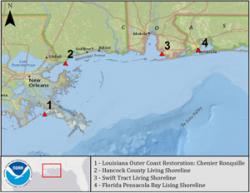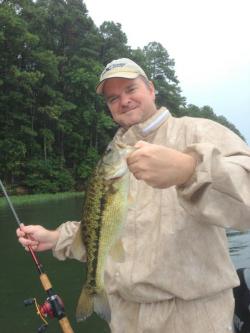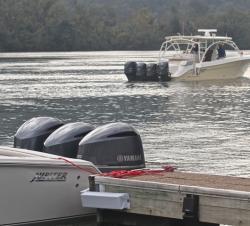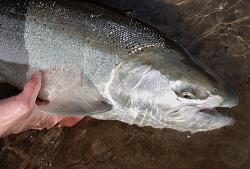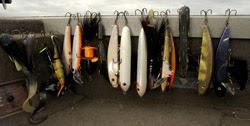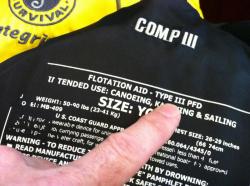NOAA, Partners Announce Major Progress on Gulf of Mexico Restoration
from The Fishing Wire
More than $600 million in new projects will offset damage from Deepwater Horizon oil spill
NOAA and its fellow Natural Resource Damage Assessment trustees in the Deepwater Horizon oil spill have announced the signing of a formal Record of Decision to implement a Gulf restoration plan. The 44 projects, totaling an estimated $627 million, will restore barrier islands, shorelines, dunes, underwater grasses and oyster beds.
This announcement marks the largest suite of Gulf early restoration projects selected thus far in the wake of the 2010 oil spill. The projects aim to address a range of injuries to natural resources and the subsequent loss of recreational use.
“Preserving, protecting, and restoring natural resources is an integral part of our efforts to foster resilience in communities nationwide, including those affected by the Deepwater Horizon oil spill,” said Kathryn D. Sullivan, Ph.D., under secretary of commerce for oceans and atmosphere and NOAA administrator. “These projects reflect an earnest commitment to the Gulf and will enhance the region’s economic, social, and ecological resilience in the future.”
As outlined in the Final Programmatic and Phase III Early Restoration Plan and Early Restoration Programmatic Environmental Impact Statement, NOAA is supporting an overall Early Restoration plan that includes both ecological and human use projects. It is also fully supporting 44 specific projects to address injury across the Gulf. Of those, NOAA is directly involved in the implementation of four projects.
Locations of Phase III Deepwater Horizon early restoration projects in which NOAA is participating. (Photo: NOAA)The largest NOAA project partnership will be with Louisiana to fund and execute restoration of beach, dune, and back-barrier marsh habitat on Chenier Ronquille, a barrier island off the state’s coast. Chenier Ronquille is one of four barrier islands proposed for restoration as part of the Louisiana Outer Coast Restoration Project that will be implemented by NOAA, the U.S. Department of Interior and Louisiana. The total cost to restore the four barrier islands is expected to be $318 million.
Alabama, Florida, Mississippi, and NOAA will partner to undertake three “living shorelines” projects. These projects involve a blend of restoration technologies used to stabilize shorelines and restore fish and wildlife habitat. The three projects are:
Alabama: NOAA will work with the state to fully implement the Swift Tract Living Shoreline Project. This project, costing $5 million, will construct approximately 1.6 miles of breakwaters covered with oyster shell to reduce shoreline erosion, protect salt marsh habitat, and restore ecosystem diversity and productivity in Mobile Bay. Restoration experts expect that over time, the breakwaters will develop into reefs, providing added reproductive and foraging habitat and shelter from predators. The 615-acre state-owned Swift Tract site is located in Bon Secour Bay and is part of the NOAA-supported Weeks Bay National Estuarine Research Reserve.
Florida: NOAA will partner with Florida for the Florida Pensacola Bay Living Shoreline Project to restore shoreline at two sites along the Pensacola waterfront. Project Greenshores Site II is located immediately west of Muscogee Wharf in downtown Pensacola. Restoration at PGS Site II has been planned in conjunction with the Sanders Beach site, three miles to the west. Both proposed sites feature breakwaters that will provide four acres of reef habitat and protect the 18.8 acres of salt marsh habitat that will be created through this project. The Pensacola project is expected to cost about $11 million.
Mississippi: NOAA will partner with the state to improve nearly six miles of shoreline as part of the proposed Hancock County Marsh Living Shoreline Project. The goal of the project is to reduce shoreline erosion by dampening wave energy and encouraging reestablishment of habitat in the region. The estimated cost is $50 million.
As the largest phase of early restoration efforts, Phase III sets a strategic approach for these and additional early restoration activities. The trustees received thousands of public comments that were instrumental in its development, and has issued a guide to the plan and projects.
These projects will be funded through the $1 billion provided to the trustees by BP, as part of the 2011 Framework Agreement on early restoration.
Ten early restoration projects already are in various stages of implementation as part of the first two phases of early restoration. Updates on these projects are available in an interactive atlas.
Early restoration provides an opportunity to implement restoration projects agreed upon by the trustees and BP prior to the completion of the full natural resource damage assessment and restoration plan. BP and other responsible parties are obligated to compensate the public for the full scope of the natural resource injury and lost use caused by the Deepwater Horizon oil spill, including the cost of assessing such injury and planning for restoration.
For more than 20 years, NOAA’s Damage Assessment, Remediation, and Restoration Program has worked cooperatively with federal and state agencies, tribes, industry, and communities to respond to oil spills, ship groundings, and toxic releases. During that period NOAA has protected natural resources at more than 500 waste sites and 160 oil spills, securing more than $2.3 billion from responsible parties.
NOAA’s mission is to understand and predict changes in the Earth’s environment, from the depths of the ocean to the surface of the sun, and to conserve and manage our coastal and marine resources. Join us on Twitter, Facebook, Instagram and our other social media channels.
